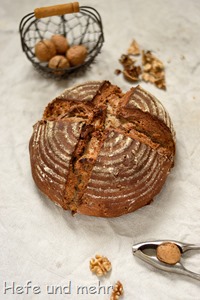 Some weeks ago a reader asked me if I had an idea for a spelt variant of the Buttermilk loaf from the beginners course. Of course I had an idea and so I send her a recipe draft. The flour used for this bread had a higher ash content – just as she asked for. A soaker made from flour and buttermilk prevents the bread from getting to dry.
Some weeks ago a reader asked me if I had an idea for a spelt variant of the Buttermilk loaf from the beginners course. Of course I had an idea and so I send her a recipe draft. The flour used for this bread had a higher ash content – just as she asked for. A soaker made from flour and buttermilk prevents the bread from getting to dry.
It took a while until I bake the bread by myself. A inflammation of my wrist kept me from hand kneading dough for a while. But since my wrist is fine again, I finally managed to knead it by hand without pain. As I like the combination of spelt and walnuts, I decided to some, too. And I slightly increased the water amount in comparison to the recipe draft. The bread has a moist and fluffy crumb with a slight darker colour due to the higher ash content of the flour and due to the walnuts.
It is a mild tasting bread which pairs well with goat cheese or honey and as it made with a straight dough it is a good alternative for moments when you need a fresh loaf in a considerable short time.


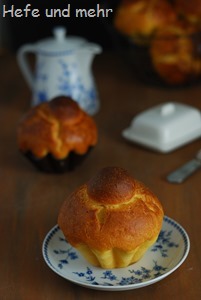 Here is –as I promised – the first spelt recipe (of hopefully many more). It is a variation of my brioche recipe, but with more egg yolk and a little water roux to increase the amount of liquid in the dough. A
Here is –as I promised – the first spelt recipe (of hopefully many more). It is a variation of my brioche recipe, but with more egg yolk and a little water roux to increase the amount of liquid in the dough. A 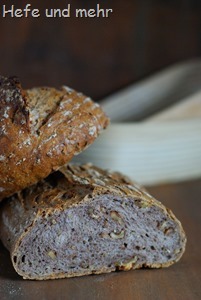 Whenever we spent our vacation in nothern Germany, I have to buy something I have troubles to find in the Rhineland: Steel cut oats! I like them very much, not for the kale stew like it is typical in North Germany, but for making porridge or baking bread. A porridge is such a good addition to a bread, adding some bite and a good deal of moisture and helping to keep the bread fresh for a long time. Especially for spelt bread it is a good addition as spelt has the tendency to bake dry without added soaker.
Whenever we spent our vacation in nothern Germany, I have to buy something I have troubles to find in the Rhineland: Steel cut oats! I like them very much, not for the kale stew like it is typical in North Germany, but for making porridge or baking bread. A porridge is such a good addition to a bread, adding some bite and a good deal of moisture and helping to keep the bread fresh for a long time. Especially for spelt bread it is a good addition as spelt has the tendency to bake dry without added soaker.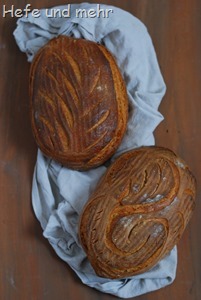 Sometimes, the best bread happens rather unplanned. Like this bread, which is a kind of a left over bread. It started when I was thinking about what to do with the remaining part of the “aromastück” I prepared when baking the “Irländer”. In the fridge was a big batch of
Sometimes, the best bread happens rather unplanned. Like this bread, which is a kind of a left over bread. It started when I was thinking about what to do with the remaining part of the “aromastück” I prepared when baking the “Irländer”. In the fridge was a big batch of 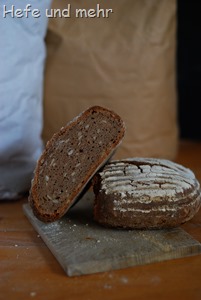 I had a nice email exchange with a reader some time ago. She just had started her own sourdough starter and had some questions about it. One was how to replace the bought dried sourdough with her own one. She mailed me the recipe and I adjust it so that it is sole leavend by sourdough. To ensure that the sourdough is strong enough, it is fed twice. I although added a soaker for seeds, to ensure they can take up enough water. As I changed much of the handling as well, add the end there are just the same ingredients but a complete different recipe. But it is worth while as it yields an aromatic, moist bread with a well balanced mild soudough flavour.
I had a nice email exchange with a reader some time ago. She just had started her own sourdough starter and had some questions about it. One was how to replace the bought dried sourdough with her own one. She mailed me the recipe and I adjust it so that it is sole leavend by sourdough. To ensure that the sourdough is strong enough, it is fed twice. I although added a soaker for seeds, to ensure they can take up enough water. As I changed much of the handling as well, add the end there are just the same ingredients but a complete different recipe. But it is worth while as it yields an aromatic, moist bread with a well balanced mild soudough flavour.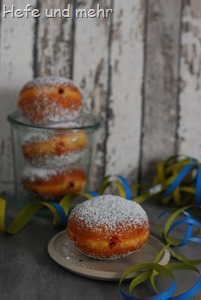
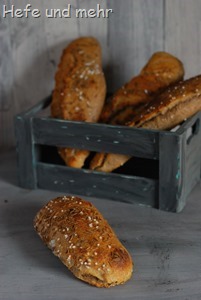
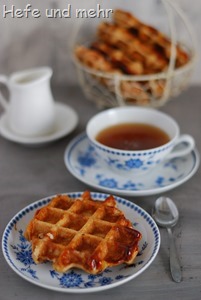 Tired, but happy I look back on the last week. Tired because I came back very late Sunday night just to leave again on early monday to morning to a mass spectrometry training in Frankfurt. Luckily there was not as much snow as forecasted and all trains were in time. Thinking on the bread festival in Berlin makes me still smiling, as it was such a good experience. I’m very happy that I met some of my Readers there!
Tired, but happy I look back on the last week. Tired because I came back very late Sunday night just to leave again on early monday to morning to a mass spectrometry training in Frankfurt. Luckily there was not as much snow as forecasted and all trains were in time. Thinking on the bread festival in Berlin makes me still smiling, as it was such a good experience. I’m very happy that I met some of my Readers there!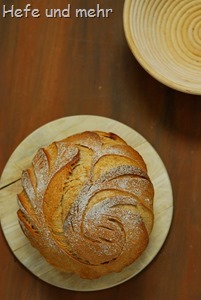 Sometimes days go in another direction then my bread baking plan was scheduled. Like last weekend when my mum called to invite me for a spontaneous lunch. So I placed my dough in the fridge after kneading. When we came home it was already late afternoon and when I calculate how long it would take to proof and bake the bread I realize it would be already past my bed time. So I decided to form the loaves and proof them over night in the fridge. With a mild sourdough, this works very well without getting a to sour bread.
Sometimes days go in another direction then my bread baking plan was scheduled. Like last weekend when my mum called to invite me for a spontaneous lunch. So I placed my dough in the fridge after kneading. When we came home it was already late afternoon and when I calculate how long it would take to proof and bake the bread I realize it would be already past my bed time. So I decided to form the loaves and proof them over night in the fridge. With a mild sourdough, this works very well without getting a to sour bread.